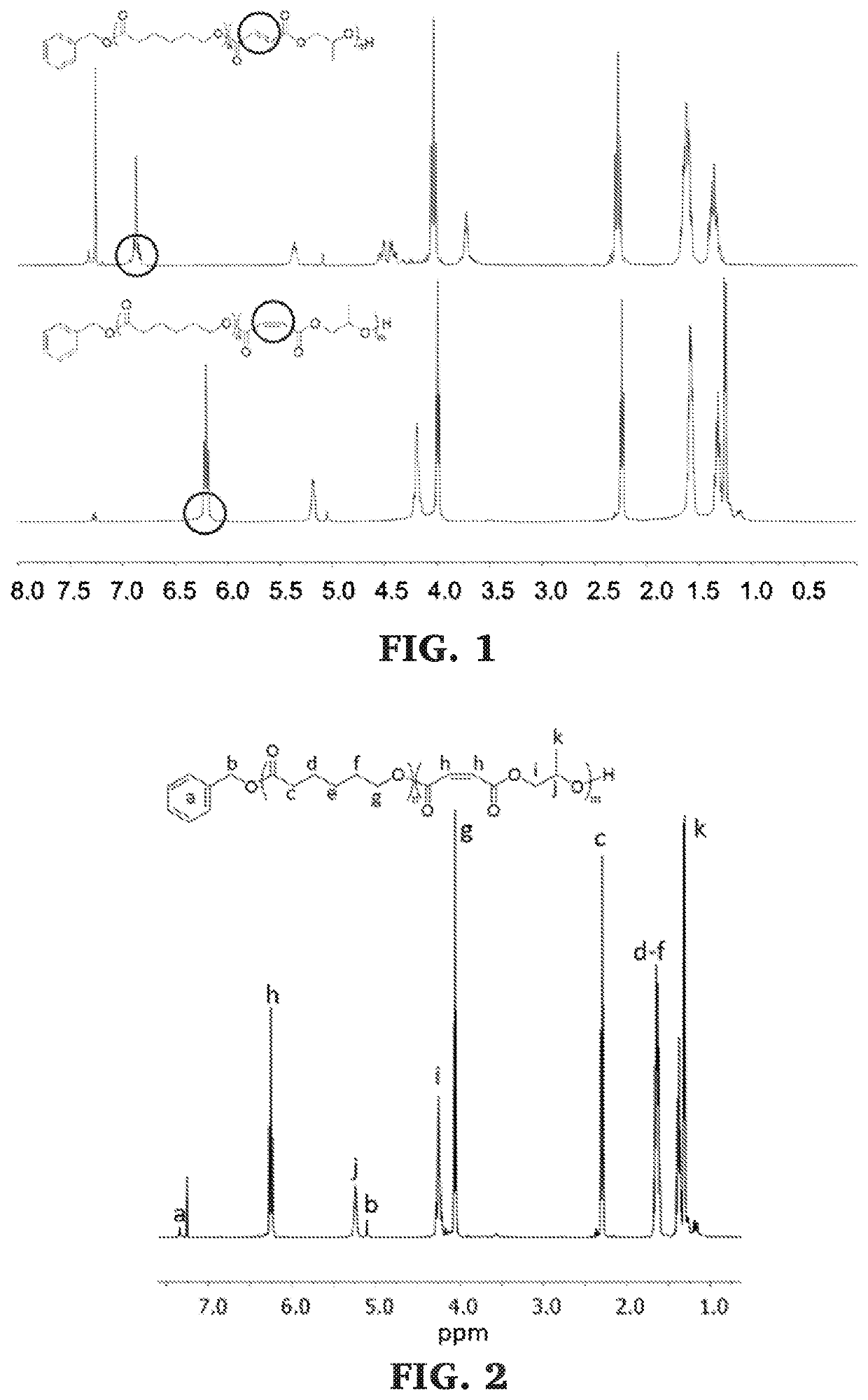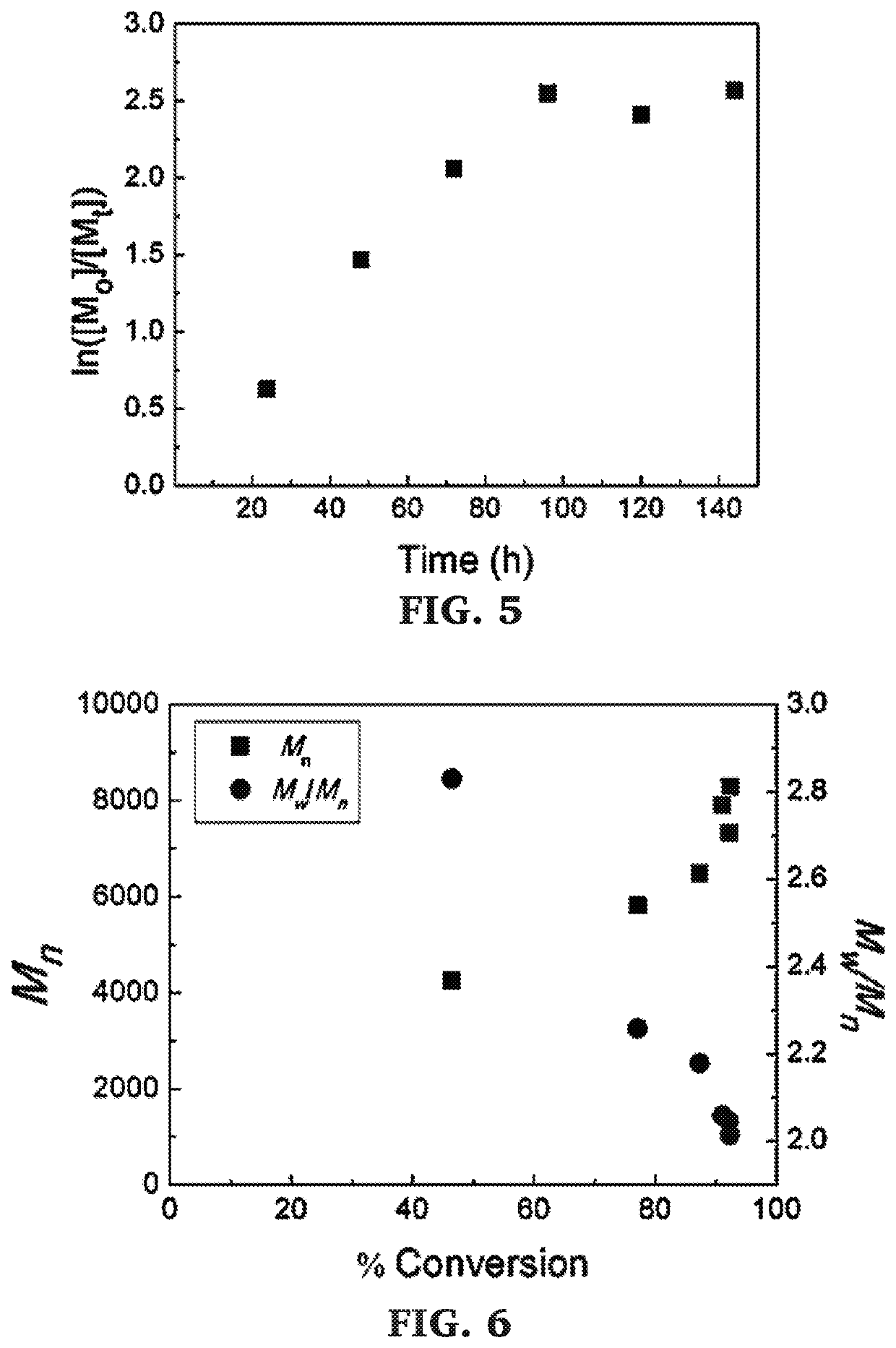Block copolymers of lactones and poly(propylene fumarate)
a technology which is applied in the field of block copolymers of lactone monomer and polypropylene fumarate, can solve the problems of limited commercial use of two separate catalysts, limited functional diversity of lactone monomer family, and limited commercial use of few post-polymerization modification options, etc., and achieves the effect of printing resin
- Summary
- Abstract
- Description
- Claims
- Application Information
AI Technical Summary
Benefits of technology
Problems solved by technology
Method used
Image
Examples
example 1
Synthesis of ε-heptalactone and γ-methyl-ε-caprolactone
[0143]A single neck round bottom flask containing 250 mL methylene chloride was cooled in an ice bath prior to addition of 223 mmol of either 2-methylcyclohexanone or 4-methylcyclohexanone and 275 mmol of m-chloroperoxybenzoic acid. After refluxing for 3 days, the reaction mixture was cooled in an ice bath and filtered over Celite and washed with 10% Na2S2O3 solution, saturated Na2CO3 solution, and brine. The organic layer was then dried with MgSO4 and filtered prior to removal of solvent via rotary evaporation. Both products were dried over calcium hydride overnight and distilled under vacuum prior to use.
[0144]ε-heptalactone:
[0145]The presence of ε-heptalactone was confirmed by 1H NMR (300 MHz, 303 K, CDCl3): δ=4.44 (m, CH2(CH3)O), 2.64 (m, C(═O)CH2), 1.73 (m, CH2CH(CH3)), 1.42 (m, CH2CH2CH(CH3)).
[0146]γ-Methyl-ε-Caprolactone:
[0147]The presence of γ-methyl-ε-caprolactone was confirmed by 1H NMR (300 MHz, 303 K, CDCl3): δ=4.23 ...
example 2
Synthesis of θ-propargyl-ε-nonalactone
[0148]30.0 mL cyclohexanone (28.4 g, 289 mmol), 28.5 mL pyrrolidine (24.7 g, 347 mmol), and 55.0 mg p-toluenesulfonic acid monohydrate (0.289 mmol) were dissolved in 60 mL toluene in a round bottom flask equipped with a Dean-Stark apparatus and reflux condenser. The solution was stirred at 150° C. for 16 h. The resulting solution was washed cooled to room temperature and washed with water and brine prior to drying with MgSO4 and solvent removal under reduced pressure. The product was purified by fractional distillation under vacuum (31.4 g, b.p. 107-114° C.) to give a pale yellow oil. This was dissolved in dry MeCN in a two neck round bottom flask then equipped with a reflux condenser prior to drop wide addition of 26.8 mL propargyl bromide (80% in toluene, 37.0 g, 249 mmol) was then added drop-wise to the solution. The reaction was stirred under reflux over night then cooled to room temperature prior to removal of solvent under reduced pressure...
example 3
Synthesis of magnesium 2,6-di-tert-butyl-4-methylphenoxide (Mg(BHT)2(THF)2
[0149]Using standard Schlenk line techniques, a schlenk was filled with 2,6-di-tert-butyl-4-methylphenol (BHT) (6.66 g, 30 mmol) and dissolved into dry toluene (30 ml) added by cannula transfer. Di-n-butylmagnesium (1M in hexane, 15 ml, 15 mmol) was added dropwise to the reaction with stirring. The reaction was stirred for a further 2 hours followed by removing solvent. Hexanes (12.5 ml) were added to the reaction vessel followed by addition of tetrahydrofuran (THF) (2.5 ml). After stirring for 2 hours under N2, solvent can be removed, and final product was obtained as a solid (See, Scheme 11).
PUM
| Property | Measurement | Unit |
|---|---|---|
| number average molecular weight | aaaaa | aaaaa |
| polydispersity index | aaaaa | aaaaa |
| Mn | aaaaa | aaaaa |
Abstract
Description
Claims
Application Information
 Login to View More
Login to View More - R&D
- Intellectual Property
- Life Sciences
- Materials
- Tech Scout
- Unparalleled Data Quality
- Higher Quality Content
- 60% Fewer Hallucinations
Browse by: Latest US Patents, China's latest patents, Technical Efficacy Thesaurus, Application Domain, Technology Topic, Popular Technical Reports.
© 2025 PatSnap. All rights reserved.Legal|Privacy policy|Modern Slavery Act Transparency Statement|Sitemap|About US| Contact US: help@patsnap.com



